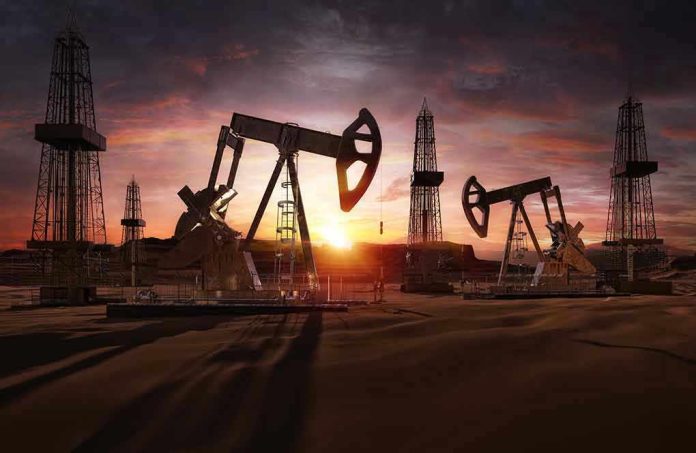
As you read this, more than a billion acres of U.S. waters are poised to be transformed by a drilling plan so vast, it could redraw the energy and environmental future of America—and spark the fiercest coastal battles in decades.
Story Snapshot
- Trump administration unveils largest-ever plan for offshore oil and gas drilling, targeting protected public waters.
- California, Florida, and Alaska coasts—many untouched for decades—face new leasing auctions and drilling risks.
- Bipartisan opposition from state leaders and environmental groups sets up legal and political showdowns.
- Plan reverses prior protections, including some established by Trump himself, and raises alarms over ecological and economic fallout.
The Billion-Acre Bet: Trump’s Offshore Drilling Expansion
The Trump administration has launched a draft plan to open nearly 1.3 billion acres of federal waters to oil and gas drilling, spanning the Pacific, Eastern Gulf, and all of Alaska. This is not a routine expansion: it is the largest offshore drilling proposal in U.S. history, targeting regions previously protected or untouched by rigs. Federal officials hope to auction up to 34 new lease sales over five years, with California and Florida—home to lucrative beaches and fiercely protective communities—now squarely in the crosshairs.
California faces six planned offshore lease sales between 2027 and 2030, while Florida’s Atlantic and Eastern Gulf coasts could see new auctions as early as 2029. Alaska’s remote Arctic waters, long shielded from drilling, are included in lease plans through 2040. The scope shocks even seasoned energy analysts: areas that survived decades of moratoriums, and some protected by Trump’s own first-term orders, now stand vulnerable to rapid industrialization. This reversal has ignited immediate backlash from state governments and environmental groups.
Why the Stakes Could Not Be Higher
California Governor Gavin Newsom calls the plan “idiotic,” vowing to fight new rigs on the state’s iconic shores. Florida leaders from both parties cite the catastrophic risk to tourism and local economies. Memories linger of the Deepwater Horizon disaster in the Gulf and the Santa Barbara spill off California—incidents that galvanized bans and moratoriums. Coastal communities fear not only pollution and oil spills, but also the destruction of fragile ecosystems and the erosion of public trust in federal stewardship.
Environmental advocacy organizations, including Earthjustice and Oceana, warn of “catastrophic risks” to marine life, climate progress, and public health. Legal experts predict a flood of lawsuits, citing previous court rulings that blocked large-scale withdrawals of public waters. Oil industry lobbyists, meanwhile, hail the plan as a “historic step” toward energy dominance, job creation, and reduced reliance on foreign oil. The debate is not academic—over 80% of existing leases in these waters have yet to start production, raising questions about the true urgency of further expansion.
Political Fault Lines and Power Dynamics
The federal government, led by President Trump and the Department of the Interior, holds the authority to lease public waters under the Outer Continental Shelf Lands Act. However, state and local governments wield substantial influence through litigation, public opposition, and regulatory maneuvers. Oil industry lobbyists remain powerful in Washington, but environmental groups have proven adept at mobilizing coalitions and swaying public opinion. The fight is not just bureaucratic; it is a public spectacle playing out in legislatures, courtrooms, and social media feeds.
Trump frames the expansion as essential for energy independence and economic growth, but critics cite the administration’s simultaneous blocking of offshore wind and clean energy funding as evidence of a broader fossil fuel agenda. The plan is currently in a draft stage, subject to public comment and inevitable legal challenges. Previous attempts to expand drilling have faltered under bipartisan pressure, especially in Florida. Yet, the scale and ambition of this proposal set a new precedent, and the outcome remains uncertain.
Impact on America’s Coasts and Climate Future
Short-term implications include heightened political conflict, legal uncertainty, and anxious coastal industries. Long-term risks loom even larger: increased oil production could mean more spills, lasting environmental damage, and setbacks for climate mitigation efforts. Tourism and fishing industries—pillars of local economies—face existential threats from pollution and habitat destruction. Public health concerns are mounting, and activism is surging among residents who see their way of life imperiled.
Industry experts argue the expansion will bolster national security and create jobs, but environmental scientists warn of irreversible harm to marine ecosystems and accelerating greenhouse gas emissions. There are no major contradictions among reputable news outlets and advocacy organizations: all agree the plan’s scale is unprecedented and its controversy fierce. Final implementation remains in limbo, hostage to court battles and the shifting tides of public opinion.
Sources:
Center for Biological Diversity



